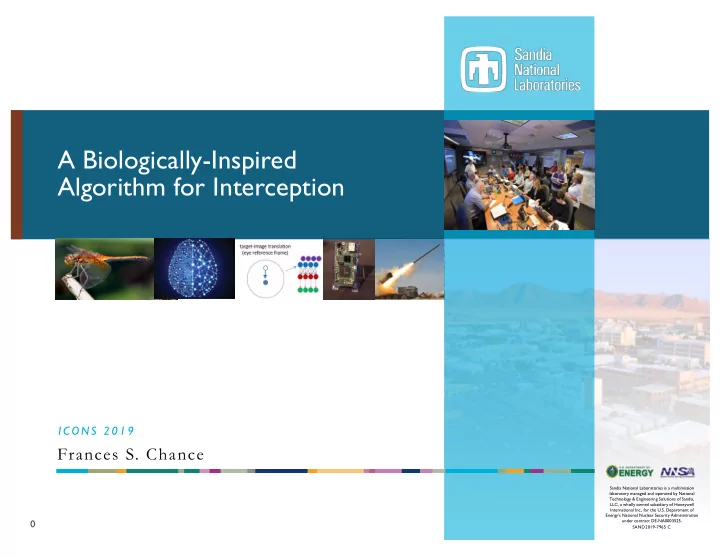

A Biologically-Inspired Algorithm for Interception I C O N S 2 0 1 9 Frances S. Chance Sandia National Laboratories is a multimission laboratory managed and operated by National Technology & Engineering Solutions of Sandia, LLC, a wholly owned subsidiary of Honeywell International Inc., for the U.S. Department of Energy’s National Nuclear Security Administration 0 under contract DE-NA0003525. SAND2019-7965 C
Interception 1 Common behavior in animals… (Image: Westend61/Getty) (Image: Wikipedia) (Image: U. Oxford) from Lin & Leonardo 2017 Still need solutions for man-made platforms… from www.scienceabc.com
Dragonflies as inspiration for an interception algorithm 2 Ø Dragonflies intercept prey when hunting Ø Good at it (90-95% capture rate) (Image: Westend61/Getty) from Lin & Leonardo 2017 Time scales of dragonfly interception computation is also very fast Ø Latency to react to prey steering: 50 ms
Dragonflies as inspiration for an interception algorithm 3 Is target-image slippage on eye enough information for a robust interception algorithm? from Lin & Leonardo 2017 Dragonflies maintain prey at a particular eye-position (foveation) during approach
Simulating a dragonfly 4 Ø dragonfly eye simulated as a 2D screen Ø fovea at the center of the target fovea / eye/screen target image Ø dragonfly maneuvers to keep prey-image on fovea Ø dragonfly and prey move at dragonfly same maximum speed (unrealistic but more challenging) Ø no restrictions on maneuverability
Simulating a dragonfly 5 Dragonfly maneuvers to keep prey-image at eye-center (fovea) dragonfly-centered reference frame physical-space reference frame
Simulating a dragonfly – target held at eye center 6 Dragonfly maneuvers to keep prey-image at eye-center (fovea) dragonfly-centered reference frame physical-space reference frame *note: videos replaced by screenshot in PDF *note: videos replaced by screenshot in PDF Classic pursuit behavior (dragonfly heads straight towards prey) Viable interception strategy except without speed overmatch can fall into ”endless pursuit”
Proportional navigation 7 aka CBDR (constant-bearing decreasing-range) or parallel navigation prey dragonfly Generates the geometrically shortest interception trajectory Dragonflies use a form of proportional navigation to intercept their prey
Can proportional navigation be implemented using prey-image 8 slippage on the eye? Ø correct “fixation spot” is calculated based on the trajectory of the prey target calculated (relative to dragonfly fixation spot trajectory) Ø dragonfly maneuvers to keep prey-image on fixation spot dragonfly Ø dragonfly and prey move at same maximum speed (unrealistic but more challenging)
Can proportional navigation be implemented using prey-image 9 slippage on the eye? Dragonfly maneuvers to keep prey-image at fixation spot (calculated) dragonfly-centered reference frame physical-space reference frame *note: videos replaced by screenshot in PDF *note: videos replaced by screenshot in PDF Potentially more robust strategy if prey has similar speed capabilities However, vulnerable to rapid evasive prey maneuvering
What if the fixation spot isn’t perfect? 10 Dragonfly maneuvers to keep prey-image at fixation spot (with noise added) *note: videos replaced by screenshot in PDF *note: videos replaced by screenshot in PDF Currently working on model for online adaptation of fixation spot (will be applicable for incomplete sensor information, evasive prey, error corrections)
Summary 11 Ø Buliding a model of dragonfly-prey interception Ø Focus on how dragonflies use visual input to calculate interception trajectories Ø Dragonfly maneuvers to maintain prey-image on a particular fixation spot Ø Pursuit behavior if fixation spot is in center of eye Ø Proportional navigation if fixation spot is calculated based upon prey trajectory Ø Ideal strategy may be some hybrid between pursuit and proportional navigation (if prey is evading) from Lin & Leonardo 2017
The End Questions? Email fschanc@sandia.gov
Recommend
More recommend